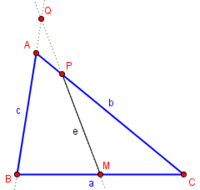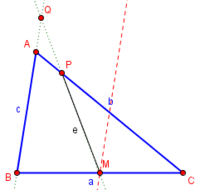Thales12345
New member
- Joined
- Jul 3, 2021
- Messages
- 30
Given:
triangle ABC with |AB|<|AC|
M is the midpoint of [BC]
P is the point on [AC] so that PM divides triangle ABC into 2 pieces with an equal perimeter
S is the intersection point of AB and PM
Proof that APS is isosceles
thanks for your help
triangle ABC with |AB|<|AC|
M is the midpoint of [BC]
P is the point on [AC] so that PM divides triangle ABC into 2 pieces with an equal perimeter
S is the intersection point of AB and PM
Proof that APS is isosceles
thanks for your help



